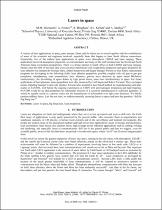JavaScript is disabled for your browser. Some features of this site may not work without it.
- ResearchSpace
- →
- Research Publications/Outputs
- →
- Journal Articles
- →
- View Item
| dc.contributor.author |
Michaelis, MM

|
|
| dc.contributor.author |
Forbes, A

|
|
| dc.contributor.author |
Bingham, R

|
|
| dc.contributor.author |
Kellett, BJ

|
|
| dc.contributor.author |
Mathye, A

|
|
| dc.date.accessioned | 2008-07-04T09:19:39Z | |
| dc.date.available | 2008-07-04T09:19:39Z | |
| dc.date.issued | 2008-04 | |
| dc.identifier.citation | Michaelis MM et al. 2008. Lasers in space. High-Power Laser Ablation VII. Taos, New Mexico, USA, 20-24 April 2008, pp 10. | en |
| dc.identifier.isbn | 9780819472069 | |
| dc.identifier.uri | http://hdl.handle.net/10204/2293 | |
| dc.description | Copyright: 2008 SPIE, The International Society for Optical Engineering | en |
| dc.description.abstract | A variety of laser applications in space, past, present, future and far future are reviewed together with the contributions of some of the scientists and engineers involved, especially those that happen to have South African connections. Historically, two of the earliest laser applications in space, were atmospheric LIDAR and lunar ranging. These applications involved atmospheric physicists, several astronauts and many of the staff recruited into the Soviet and North American lunar exploration programmes. There is a strong interest in South Africa in both LIDAR and lunar ranging. Shortly after the birth of the laser (and even just prior) theoretical work on photonic propulsion and space propulsion by laser ablation was initiated by Georgii Marx, Arthur Kantrowitz and Eugen Saenger. Present or near future experimental programs are developing in the following fields: laser ablation propulsion, possibly coupled with rail gun or gas gun propulsion; interplanetary laser transmission; laser altimetry; gravity wave detection by space based Michelson interferometry; the de-orbiting of space debris by high power lasers; atom laser interferometry in space. Far future applications of laser-photonic space-propulsion were also pioneered by Carl Sagan and Robert Forward. They envisaged means of putting Saenger’s ideas into practice. Forward also invented a laser based method for manufacturing solid antimatter or SANTIM, well before the ongoing experiments at CERN with anti-hydrogen production and laser-trapping. SANTIM would be an ideal propellant for interstellar missions if it could be manufactured in sufficient quantities. It would be equally useful as a power source for the transmission of information over light year distances. We briefly mention military lasers. Last but not least, we address naturally occurring lasers in space and pose the question: “did the Big Bang lase?” . | en |
| dc.language.iso | en | en |
| dc.publisher | SPIE | en |
| dc.subject | Laser propulsion | en |
| dc.subject | Solid antimatter | en |
| dc.subject | Big bang laser | en |
| dc.title | Lasers in space. | en |
| dc.type | Article | en |
| dc.identifier.apacitation | Michaelis, M., Forbes, A., Bingham, R., Kellett, B., & Mathye, A. (2008). Lasers in space. http://hdl.handle.net/10204/2293 | en_ZA |
| dc.identifier.chicagocitation | Michaelis, MM, A Forbes, R Bingham, BJ Kellett, and A Mathye "Lasers in space." (2008) http://hdl.handle.net/10204/2293 | en_ZA |
| dc.identifier.vancouvercitation | Michaelis M, Forbes A, Bingham R, Kellett B, Mathye A. Lasers in space. 2008; http://hdl.handle.net/10204/2293. | en_ZA |
| dc.identifier.ris | TY - Article AU - Michaelis, MM AU - Forbes, A AU - Bingham, R AU - Kellett, BJ AU - Mathye, A AB - A variety of laser applications in space, past, present, future and far future are reviewed together with the contributions of some of the scientists and engineers involved, especially those that happen to have South African connections. Historically, two of the earliest laser applications in space, were atmospheric LIDAR and lunar ranging. These applications involved atmospheric physicists, several astronauts and many of the staff recruited into the Soviet and North American lunar exploration programmes. There is a strong interest in South Africa in both LIDAR and lunar ranging. Shortly after the birth of the laser (and even just prior) theoretical work on photonic propulsion and space propulsion by laser ablation was initiated by Georgii Marx, Arthur Kantrowitz and Eugen Saenger. Present or near future experimental programs are developing in the following fields: laser ablation propulsion, possibly coupled with rail gun or gas gun propulsion; interplanetary laser transmission; laser altimetry; gravity wave detection by space based Michelson interferometry; the de-orbiting of space debris by high power lasers; atom laser interferometry in space. Far future applications of laser-photonic space-propulsion were also pioneered by Carl Sagan and Robert Forward. They envisaged means of putting Saenger’s ideas into practice. Forward also invented a laser based method for manufacturing solid antimatter or SANTIM, well before the ongoing experiments at CERN with anti-hydrogen production and laser-trapping. SANTIM would be an ideal propellant for interstellar missions if it could be manufactured in sufficient quantities. It would be equally useful as a power source for the transmission of information over light year distances. We briefly mention military lasers. Last but not least, we address naturally occurring lasers in space and pose the question: “did the Big Bang lase?” . DA - 2008-04 DB - ResearchSpace DP - CSIR KW - Laser propulsion KW - Solid antimatter KW - Big bang laser LK - https://researchspace.csir.co.za PY - 2008 SM - 9780819472069 T1 - Lasers in space TI - Lasers in space UR - http://hdl.handle.net/10204/2293 ER - | en_ZA |






